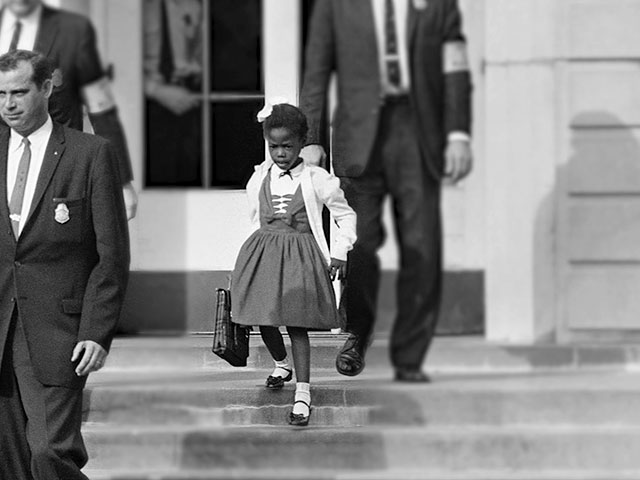Ruby Bridges Shares the Key to Overcoming Racism
“When we turned the corner, I saw all of these people."
November 14, 1960 – it was six-year-old Ruby Bridges’ first day of school at William Frantz Elementary in New Orleans.
Ruby says, “I remember them chanting, ‘2, 4, 6, 8, we don't want to integrate!'"
It had been six years since the U.S. Supreme Court mandated the desegregation of schools. Washington was now putting pressure on Louisiana and other states that had yet to comply. In a veiled attempt to appear compliant, city officials in New Orleans gave 150 black kindergarteners an entrance exam – one they had no chance of passing. But 6 of the 150 kindergarteners passed that test – Ruby was one of them.
“Everybody was coming over and congratulating my parents. ‘She's so smart. She passed. We're so proud of her.’ So, I actually thought that I was so smart that I passed this test that would allow me to go from first grade to college," remembers Ruby.
Three girls, including Ruby, were selected to attend William Frantz Elementary. But by the first day, November 14, the other two girls dropped out, making Ruby the only black student in the school.
“My parents only said, ‘Ruby, you're going to go to a new school today, and you'd better behave.' There was a knock at the door, and four very tall white
men were standing at the door. And I remember looking at them and thinking, ‘Well, who are they?'”
Those four men were United States Marshals sent by President Eisenhower. Their job was to escort Ruby to and from school. One of the men was Charles Burks.
Charles recalls, “We had a lot of demonstrations against what we were doing. The main thing was be sure nothing happened to her. We’d tell her, ‘Just stay close to us. We’ll going to be all right.'"
Ruby says, “There were barricades everywhere. There were cameras everywhere. I thought I'd stumbled into a parade. I actually thought it was Mardi Gras."
Charles says, “It didn’t seem to bother her any. She was just doing what she had been told to do."
Ruby’s mother went as well. Once the marshals escorted them inside, they were taken to the principal’s office. They stayed there all day, while white parents scrambled in and out of classrooms, taking their children out of school.
Ruby says, "500 kids walked out of school that day, and I didn't know what was going on. Because nobody explained anything to me. Finally the bell rang and someone came into the office and they said, 'school is dismissed. You can leave.' and I remember sitting there and thinking, 'Wow! College is easy.'”
By the next day, the crowds had doubled.
Ruby remembers, “They kept pointing at me and shouting. ‘We're going to poison her. We're going to hang her.'"
Charles says, “I knew what we were doing was right, and we were going to make sure it happened."
This time Ruby was taken to a classroom.
Ruby says, “I remember looking into that classroom, and all I saw was empty desks. I didn't see one child."
But one other person was there, her teacher, Barbara Henry. Coming from Boston, she was the only one willing to teach Ruby.
Ruby says, “I remember looking at her and thinking, ‘She's white!' I’d never seen a white teacher before. She looked exactly like the people outside. She wasn’t. I always say that she showed me her heart."
The following week, students started to return. But the principal confined Ruby to her classroom and didn’t allow her to play outside or eat in the cafeteria.
“I remember going to the back of the classroom to sharpen my pencil and you could look onto the playground. There were these huge oak trees, swings and slides and basketball goals, and I kept thinking as I sharpened my pencil, ‘Where are the kids?'"
By the end of the school year, the protests had disbanded and Ruby was finally allowed to meet the other children. She remembers, “I finally found them, you know? I was so excited. So I went in to play with them. This little boy looked at me and he said, ‘I can’t play with you. My mom said not to play with you because you're a nigger.'"
“So that's what this is about? It's not Mardi Gras and this isn't college. It's about me. It’s about me and the way I look and the color of my skin. And in my mind, that was okay. Yes, he hurt my feelings, but I wasn't angry with him because I felt like he was explaining to me why he couldn't play with me. If my parents said, ‘Ruby, don't play with him he's Asian, Hispanic, Indian, Muslim, White, mixed race, Jewish, Gay.' I would not have played with him.”
“I didn't feel like there was anything for me to forgive. The fact that in my mind he was explaining to me and that I would have done the same thing. It wasn't like I was angry with him, so there was nothing there to forgive. The fact that when I passed the crowd I thought it was Mardi Gras, there was nothing there for me to forgive."
Ruby returned to William Frantz the following year; she had a new teacher and a room full of classmates. She went on to attend an integrated high school and eventually graduated from Kansas City Business School with a degree in travel and tourism. And when she married and began raising a family, she taught them to rely on God.
Granddaughter Annie says, "She always falls on her faith and she makes sure
that you do so as well. So it doesn't matter what you go through, doesn’t matter who hates you, who dislikes you. As long as you have that faith and that relationship with God, you're fine."
Ruby would return to William Frantz in 1993, when she enrolled her four nieces. She witnessed the same racism she had seen as a little girl. To build bridges between the races, she volunteered as a parent liaison and established an after school multi-cultural art club. Soon after, she launched the Ruby Bridges Foundation and began sharing her story with students all over the U.S. She believes that true change takes the heart of a child.
Ruby says, “I see hope that most of us don't see. I'm in schools every day. I am so humbled by the way my story moves kids. It's so simple. How Mrs. Henry didn't judge me. How all I wanted was a friend. Kids get that. They understand that." “Our kids know nothing about racism. It's us as adults. We take racism and we pass it on to our kids. And that's why it's still around. Each and every one of us come into the world with a clean heart. I believe that if we are going to get past our racial differences, even today, it's going to come from our kids."
It’s been over 55 years since Ruby walked up those steps, taking her place in history. Today, her legacy continues to make a difference.
Charles says, “I was happy to see what she did. Because I knew it could be done. And I’ve always told Ruby that I’m glad I was able to have something to do with it."
Annie says, “To have equality, it takes someone with courage to make that change so that we can come together. And you have to have a great faithful foundation to stand up for what you truly believe. My superhero, she does that every day."
Ruby concludes, “Out of the commandments, the one you should keep is Love Thy Neighbor. That is the key. I have to care about you as a person and a human being. I really believe the longer I live that it really has everything to do with love.”




